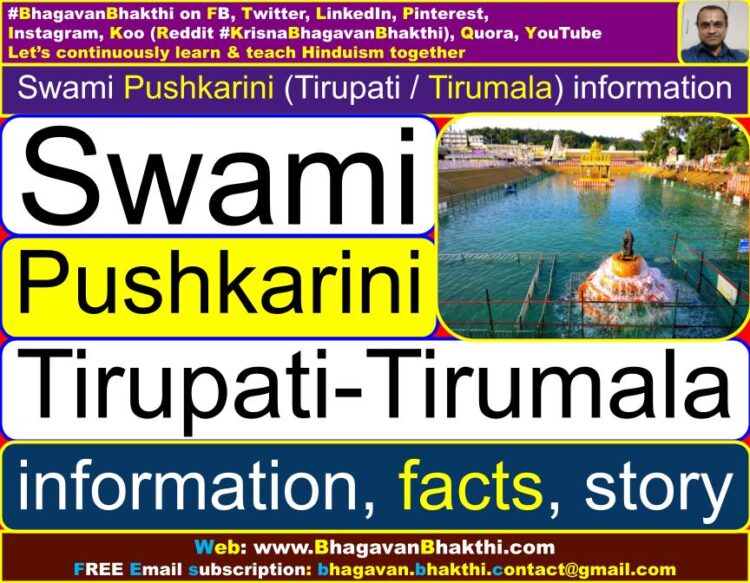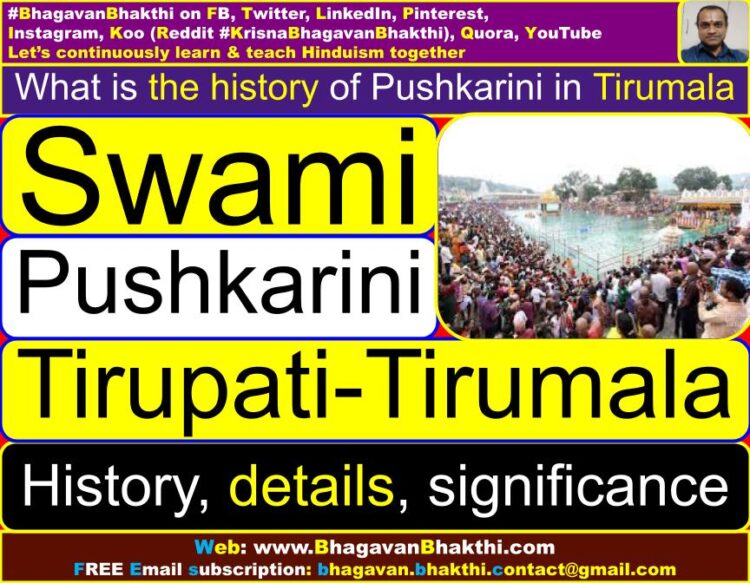Swami Pushkarini (Tirupati / Tirumala) information, story | What is the history of Pushkarini in Tirumala? | What is the importance of Pushkarini?
Namaste friends, how are you doing today? Welcome to #BhagavanBhakthi website / blog.
Bhagavan Lord Sri Srinivasa (Venkateswara) (Balaji) (Vishnu) (Krishna) (Rama) and Swami Pushkarini blessings to you and your family!
In this website / blog, you will always learn about #Hinduism #Sanskrit language.
Also subscribe to my YouTube channel from this link #BhagavanBhakthi to view videos about #Hinduism #Sanskrit language.
Just before going to “Swami Pushkarini (Tirupati / Tirumala) information, story | What is the history of Pushkarini in Tirumala? | What is the importance of Pushkarini?“, let us have some brief information.

Before the start of the Kali Yuga, Goddess Sri Sarasvati Devi did the penance and wanted to be better than ‘Gangaadi sakala tirthas’ (Ganga and other tirtha kshetras / pilgrimage places’ rivers).
At that particular time Maharshi Pulastya came there. Maharshi Pulastya was Goddess Sri Sarasvati Devi’s son. Goddess Sri Sarasvati Devi neglected Maharshi Pulastya.
Thus, Maharshi Pulastya cursed his own mother Goddess Sri Sarasvati Devi’s intention of becoming the superior does not yield good and best result.
On the other hand, Goddess Sri Sarasvati Devi also cursed Maharshi Pulastya to born in a Rakshasa (demon) family.

(Please remember that these all are vidambana / pastimes / drama / leelas of Lord Sri Vishnu. We should never take it on the negative way.)
Goddess Sri Sarasvati Devi continued her tapas / penance once again and pleased Lord Sri Vishnu and asked Lord Sri Vishnu to make her superior than all rivers.
But, Lord Sri Vishnu informed Goddess Sri Sarasvati Devi that, as Maharshi Pulastya has cursed her and thus she can’t become superior than Goddess Sri Ganga Devi (river).
But instead, Goddess Sri Sarasvati Devi can become superior amongst all Pushkarinis, and asked her to go to Sheshagiri (Today’s Tirumala / Tirupati hills) and stay there and that he (Lord Sri Vishnu) will also come there at a later date.
In this way, ‘Svami Pushkarini’ became the shrestha (Divinely better) Pushkarini (pond) among all the Pushkarinis.
[We should always remember that Goddess Sri Sarasvati Devi is much higher Devata / Demigod in the hierarchy / taratamya than Goddess Sri Ganga Devi and other divine rivers.]
[But to teach to the world lessons, Lord Sri Vishnu is playing krida / game (doing Vidambana / pastimes). Goddess Sri Sarasvati Devi will always remain higher Devata / Demigod than Goddess Sri Ganga Devi and other divine rivers].
Snana (Bath), paana (Drinking), Pitru-Shraaddha (Ancestors rituals), Shaligrama daana (Donation), Gau (cow) daana and other daanaas in Svami Pushkarini will yield special punya / good deeds / blessings.
In Svami Pushkarini there are 3 ½ Crore tirthas (divine rivers). Also, there is a ‘saannidya’ (Divine presence) of svayam (directly) Lord Sri Vishnu in Svami Pushkarini.
The Matsyas (fishes), Kurmas (tortoises), Sarpas (snakes), Makaras (crocodiles) in this tirtha are svayam (directly) Devatas / Demigods.
Earlier a King named Shankha did the snaana (bath) in Svami Pushkarini with proper sankalpa and got kingdom, and he reached directly to Svarga (Divine Heaven).
A Brahmin named Narayana did the snaana (bath) in Svami Pushkarini and got Vishnu Loka (A permanent place in Vaikuntha).
Lord Sri Rama did snaana (bath) here in Swami Pushkarini, and got back Goddess Sri Sita Devi.
[We should remember that Lord Sri Rama need not perform anything for himself, but he took bath in Swami Pushkarini for ‘loka shikshanaartham’ (To teach the lessons to world), that to teach lessons to the ordinary humans].

But instead, since Lord Sri Rama did snaana (bath) here, Svami Pushkarini became even more pavitra (Divinely purified).
That is the greatness of our Great Lord Sri Rama or any of Lord Sri Vishnu’s avatar(s). “Jai Sri Rama”.
Narayana (A Brahmin) and Swami Pushkarini story is as given below:
Earlier in Venkatadri (today’s Tirumala / Tirupati hills) a Brahmin named Narayana used to bathe in Swami Pushkarini and perform penance.
Pleased with his penance, Lord Sri Vishnu (Srinivasa) came before him. Since then the place was known as Narayanadri or Narayanachalam or Narayanachala or Narayangiri.
On the western side of Swami Pushkarini (Pond), Lord Sri Varaha (an avatar of Lord Vishnu) resides there along with Goddess Sri Bhudevi. There, Lord Sri Vishnu (Srinivasa) wanted to have some place for his stay.
Lord Sri Srinivasa (Vishnu) decided to stay under the Tamarind (Tintrini) tree and Valmika (anthill) (in the hiding place of the snake) and stayed there for 10,000 years. At that time, the place was ruled by King Chola.
King Chola (According to Brahmanda Purana, 7th Adhyaya), there lived King Chola who followed Dharma, he once went hunting in Seshachalam (present day Tirumala / Tirupati Hills) and killed many wild animals which were causing trouble to the innocent people.
Once, he saw a beautiful, young girl on the way, who was a Naga Kanya (snake woman), and a daughter of Dhananjaya, the King of the Serpents.
During the reign of the King Chola, cows gave milk in abundance, children respected their parents and elders, it rained regularly, and farmers grew abundant crops.
At that time Lord Sri Brahma Deva came in the form of a cow, Lord Sri Rudra Deva in the form of a calf and Goddess Sri Lakshmi Deva came as a cowherd [to do Lord Sri Srinivasa Seva (to serve)], all the three came to King Chola palace.

Goddess Sri Lakshmi Devi gave the cow and the calf to the king and went to Karaveerapura (Today’s Kolhapur) saying that the cow’s milk should be reserved only for Lord Sri Srinivasa. But the king forgot Goddess Sri Lakshmi Devi’s command and used cow’s milk for his child.
That calf and cow were going to graze with other 2000 cows and were looking for the place of Lord Sri Srinivasa and found it in Valmika (anthill) near ‘Swami Pushkarini’ and fed the whole milk to Lord Sri Srinivasa.
Seeing that the cow was not giving milk for a long time, the king’s wife scolded the local cowherd and asked if the local cowherd was taking milk for himself and his family.
The next day, the local cowherd followed the calf and the cow, which went to the Valmika (anthill) and fed the milk to Lord Sri Srinivasa who was present inside the Valmika (anthill).
This local cowherd got angry and took a weapon and wanted to hit at the cow.
Lord Sri Srinivasa who was in Valmika (anthill) came out and pushed the local cowherd back, and the weapon hit Lord Sri Srinivasa on the head and blood started flowing from Lord Sri Srinivasa’s head.
The local cowherd who saw Lord Sri Srinivasa bleeding profusely from the head died of shock on the spot itself.
The cow went to the king’s palace and cried from outside the king’s palace. The king asked his servants to know why this cow was crying.
The servants followed the cow and reported that the local cowherd was dead and bleeding profusely. The king was surprised to see the amount of blood.
At this time, Lord Sri Srinivasa emerged from Valmika (anthill) and cursed King Chola to have a paishachika (ghost) life.
Lord Sri Srinivasa cursed King Chola, saying that he was the head of the state (King) and responsible for all events happening in his Kingdom, and also he was responsible for the mistakes of his servants.
Vaikuntha Ekadashi, Dwadashi and Swami Pushkarini information is as given below:
Lord Sri Vishnu is the ‘abhimani devata’ (presiding deity) of Ekadashi and Dwadashi days and worshiping Him on Dwadashi day is part of the ‘Ekadashi Vrata’ (Ekadashi fasting).
The Dwadashi day after Vaikuntha Ekadashi is called Mukkoti Dwadashi which falls in the sacred solar month of Dhanurmasam.
Special significance is given to ‘Mukkoti Dwadashi’ in Tirumala (Tirupati) which is the abode of Lord Sri Venkateswara (Srinivasa).

According to ‘Sri Venkatachala Mahatmya’ or ‘Sri Venkateswara Mahatmya) of Brahma Purana, Swami Pushkarini in Tirumala (Tirupati) is a manifestation of holy river Saraswati (Goddess Sri Saraswati).
Goddess Sri Saraswati performed severe penance of Lord Sri Srinivasa (Venkateswara) and obtained a boon from him and is permanently resided in Tirumala (Tirupati) as directed by the Supreme God Lord Sri Srinivasa (Vishnu).
According to the boon, Lord Sri Vishnu granted Swami Pushkarini the status of ‘Shreshthtva’ (श्रेष्ठत्व) (Śrēṣṭhatva) (superiority excellence) among all Tirthas (Pushkarinis) (divine ponds).
According to ‘Sri Venkateswara Mahatmya’, as per the command of Lord Sri Vishnu, 3½ crore holy tirthas (divine rivers and ponds) in the whole earth enter ‘Swami Pushkarini’ at Tirumala (Tirupati) on the day of ‘Mukkoti Dwadashi’ to purify themselves.
Along with this anecdote, taking a bath at ‘Swami Pushkarini’ on ‘Arunodaya Kalam’ (before sunrise) on the day of ‘Mukkoti Dwadashi’ is considered highly meritorious and equal to taking a bath at all 3½ crore holy Theerthas.
This day is worshiped as ‘Sri Swami Pushkarini Theertha Koti’ in Tirupati Tirumala temple calendar.
One can imagine the sanctity of ‘Swami Pushkarini’ at Tirupati Tirumala and take a bath in this holy tirtha is recommended for pilgrimage to Tirupati Tirumala holy place.
The pond on the banks of which Lord Sri Srinivasa (Venkateswara) resides is ‘Pavana-Punya Tirtha’ (Blessed with the highest good deeds) and only virtuous people are allowed to reside on the banks of such a pond.
(This is as said by Sanakakumara and as per Padma Purana’s Sri Venkatachala Mahatmya and Swami Pushkarini Mahatmya.)
According to ‘Sri Venkatachala Mahatmya’ of Brahma Purana, in Venkatadri (Today’s Tirumala / Tirupati Hills), the holy abode of Lord Sri Venkateswara (Srinivasa), has 66 crore holy theerthas.
Out of which 1008 are highly important, out of which 108 are considered ‘Jnana Pradayini’ (providers of divine knowledge), out of which 68 are capable of bestowing ‘bhakti and vairagya’ (devotion and austerity),
out of which 7 are ‘mukti pradayini’ (providers of liberation) and out of which one is most divine and meritorious, that is, it’s name is Swami Pushkarini Theertha.
According to Maharshi Bharadwaja, ‘Swami Pushkarini Smaranam’ (remembering Swami Pushkarini) while getting out of bed in the early morning is ‘Punyaprada’ (highly auspicious).
According to the Varaha Purana, King Dasharatha visited the ‘Venkatachala Kshetra’ (present-day Tirumala / Tirupati Hills) in search of his ‘putra bhagya’ (to get a son) as directed by Maharishi Vasishtha and performed penance at the holy ‘Swami Pushkarini’ tirtha.
Lord Sri Rama is said to have visited and bathed in the holy waters of ‘Swami Pushkarini’ during his forest exile.
Born in India where unlimited pilgrimage sites still exist today, we Indians should be very and divinely proud of.
One can imagine the sanctity of ‘Swami Pushkarini’ at Tirupati Tirumala, where Lord Sri Srinivasa (Venkateswara) (Vishnu) (Balaji) resided blissfully since time immemorial.
Tirumala Sri Vari Brahmotsavam, Chakra Snana (bath) and Swami Pushkarini story (information) is as given below:
On the morning of the 9th day i.e. the last day of Tirumala Srivari Brahmostava, a special abhishekam known as ‘avabhrita snaana’ (bathing) is performed to Lord Sri Venkateswara ‘Utsava Murthy’ (deity).
This bathing is done in the complex for Lord Sri Venkateswara and his consorts Goddess Sridevi (Lakshmi) and Goddess Sri Bhudevi Devi in the comples of Lord Sri Varaha on the banks of the holy Swami Pushkarini.
Then the murthy (deity) of Sudarshana Chakra (divine weapon of Lord Vishnu) is immersed in the holy water of Swami Pushkarini.
At that time we easily find huge gatherings of devotees flocking to bathe in Swami Pushkarini water simultaneously.
It is said in Hindu Puranas that one gets rid of sins by simultaneously bathing in Swami Pushkarini along with Sudarshan Chakra at this particular moment.
Chakra Snaana (bath) marks the formal end of the nine-day Tirumala Srivari Brahmotsavam, followed by ‘Dvajarohanam’ in the evening.
The ninth day of the festival must invariably coincide with the ‘Shravana Nakshatra’, which forms the date of the Brahmotsava schedule every year.
Continue reading : Information about Lord Sri Srinivasa, Goddess Sri Padmavati Devi and Tirupati hills (Tirumala)
To know full story of Lord Sri Srinivasa Kalyanam (Lord Balaji marriage), you can check from here:
Lord Srinivasa Kalyanam / Lord Balaji marriage full and correct story
More information will be added to this on regular, please visit after some time to know more information.
To watch videos on #Hinduism #Sanskrit language, SUBSCRIBE to my YouTube channel from this below link:
#BhagavanBhakthi YouTube channel
To know more about “Lord Sri Krishna information, facts, importance, significance, etc.“, kindly click the below link:
Lord Sri Krishna information, facts, importance, significance, etc.
To know “Pandavas unknown facts and information“, you can visit the below link:
Pandavas unknown facts and information
Dear friends, if you need any clarifications about this post, kindly let me know, I will definitely try to answer all of them.
Also your one LIKE, one COMMENT, One Share, one SUBSCRIPTION is highly important.
This will help to know the quality of this content and also it will be helpful to know if any improvements is required for the content.
If you feel this content is useful to you and has helped you to improve your knowledge, kindly share this with your well-wishers.
Because “SHARING MEANS CARING”.
For receive FREE EMAIL SUBSCRIPTION about #BhagavanBhakthi, you can send an email to bhagavan.bhakthi.contact@gmail.com from your email ID.
NAMASTE!
SRI GURUBHYO NAMAHA
OM NAMO NARAYANAYA
Sri Krishnaarpanamastu
Share in Social Media